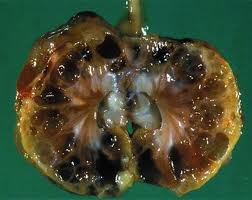Diabetes Mellitus
- Caused by inadequate secretion of insulin from islet cells in the pancreas
- Less insulin means blood sugar level tends to rise

- Cells of proximal tubule are supplied with enough ATP to reabsorb .1 % blood sugar, but with disease much higher blood sugar concentrations are found with the excess sugar remaining in the nephron
- Excess sugar provides osmotic pressure which opposes the osmotic pressure created by other solutes that have been actively transported out of the nephron
- Water remains in the nephron and is lost with the urine which makes individuals with diabetes mellitus lose large volumes of urine, explaining why they are constantly thirsty
- The water lost with the excreted sugar must be replenished
Diabetes Insipidus
- Destruction of ADH- producing cells of the hypothalamus or the destruction of the nerve tracts leading from the hypothalamus to the pituitary gland can cause this disease
- Without ADH to regulate water reabsorption, urine output increases, with some extreme cases as much as 20 L of dilute urine being produced each day producing a strong thirst response
- A person with this type of diabetes must drink a lot of water to replenish what he or she has not been able to absorb
Bright’ Disease
- Also called nephritis
- Not a single disease, but a broad description of many diseases characterized by inflammation of nephrons
- One type affects the tiny blood vessels of the glomerulus
- Toxins produced by invading microbes destroy the tiny blood vessel, altering the permeability of the nephron
- Proteins and other large molecules are able to pass into the nephron, and because no mechanism is designed to reabsorb them, the proteins remain in the nephron and creates an osmotic pressure that draws water into the nephron
- The movement of water into the nephron increases the output of urine
Kidney Stones
- Caused by the precipitation of mineral solutes from the blood
- Categorized into two categories: Alkaline and Acid stones
- Sharp sided stones can lodge in the renal pelvis or move into the narrow ureter
- Delicate tissues are torn as the stone moves towards the bladder
- The stone can move further down the excretory package and lodge in the urethra, causing excruciating pain as it moves
